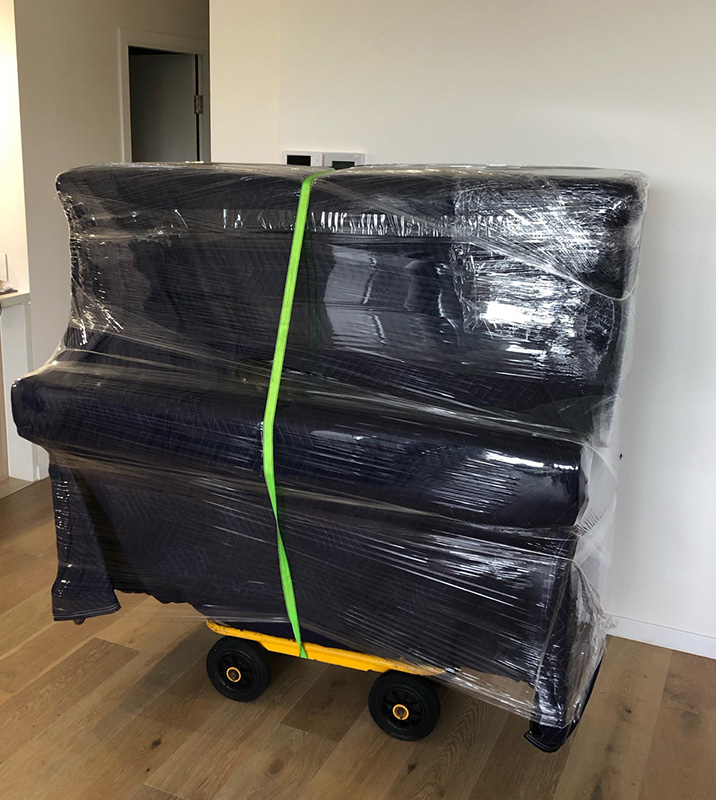
Find a local removalist
- Inspiration /
- Lifestyle /
- Real estate & moving /
- How to move a piano
How to move a piano
What's the best way and how much does it cost?
Ever needed to move a piano only to realise it’s quite a big undertaking? Musical instruments are usually quite delicate and have some intricate parts and attachments. Most of them are small and relatively easy to transport. For example, you can place a violin or cello inside a secure case and carry it to the destination. Unfortunately, not all musical instruments are as easy to transport and items like a piano or harpsichord require special arrangements. Here are our top tips on how to move a piano.
Why is moving a piano so complicated?
It’s not as easy to transport a piano because it is an odd shape, is bigger in size and heavier than most musical instruments. Pianos might look sturdy and solid on the outside, but they have a very delicate mechanism inside that can be disrupted at the slightest bump or movement. Pianos have delicate, little felt hammers, tightly wound strings, awkwardly positioned pedals, keys and some of the other mechanisms.
To prevent damage during the move, it’s a good idea to hire a professional that has experience with moving a piano.
How much does it cost to move a piano?
Hiring a professional removalist is a wise decision, not to mention a worthy investment. By seeking the assistance of professional movers to help you transport your piano with tender care and avoid injuries. Cost can vary depending on the size of your piano, destination, whether the piano needs to go upstairs need to be navigated and the type of piano you have.
It is best to entrust the safe handling of your specialised instrument to a moving company that specialises in piano removals for the following reasons:
- Weight considerations. Pianos weigh from around 150kg to as much as 600kg or more. With this in mind, pianos should not be moved long distances or out of the house on its casters, as these casters are for moving short distances across the room. Casters can deteriorate over time and if this happens and you try to move your piano yourself, it can tear your carpet or gouge your hardwood floors.
- Financial factors. You might think that having expert piano removalists will cost an arm and a leg. However, requesting a quote may change your mind, as there are varied factors involved in moving such a fragile acoustic instrument.
Pianos do not typically come cheap, and some pieces are considered antique or beloved heirlooms. Moving a piano yourself will most probably mean that it won’t be covered by insurance; however, when professional removalists do it, they can offer you insurance.
- Equipment concerns. Pianos have intricate workings with roughly 12,000 individual parts. Piano removalists have years of experience, skills and knowledge about pianos and their proper handling requirements. From possible dismantling to applying the safest possible techniques to turn a piano, to getting it out of the door and safely into a moving truck, these specialists will know exactly what to do to avoid or minimise damage.
If you intend to move the instrument on your own, you should arrange for some assistance from your friends and family.

How to move a piano
Moving a piano requires careful planning and execution. It is important to get the instrument to its destination without any harm. Here are some tips that can help you move different types of pianos.
What do you need?
Before you attempt to move the piano, you need to make some preparations and ensure you have everything you need. Here is a list that can help you:
- Get help. A team of people capable of lifting heavy loads to help you move. You can’t move a piano on your own without assistance.
- Protect it. A sheet or plastic wrap to cover the piano and protect it from dust and debris during transit. Also consider taking protective measures for things such as hardwood floors, carpet and walls.
- Get some wheels. A moving dolly is absolutely essential if you want to move your piano. They are essentially flat load-bearing boards with wheels attached.
- Keep your piano steady. You need furniture straps to keep the piano anchored to the moving dolly and then to the floor of the moving truck. These straps will ensure the instrument doesn’t shift around during transit.
- Hire a truck. You can’t move the piano without a moving truck, so you’ll need to hire one before you pack the piano. It’s a good idea to reserve a moving truck a few weeks in advance to ensure there are no problems in the scheduling.
Do not attempt to move the piano on its wheels because that will damage the instrument permanently. The wheels attached to the piano are designed for small distance moves on smooth surfaces.
Protect your piano
You can consult your professional piano mover regarding ways to protect your piano before they move it, but here are some basic reminders that you can take note of:
- Do not leave the key in the lid. This is to make sure that any keys to lock the piano don’t get lost during the move.
- Place a drying agent inside the piano if it is being stored. If a piano is left in a humid environment, the wood can warp and crack over time.
- Clear the path where the piano will most likely pass. Also, leave enough space surrounding the piano for the movers to be able to move freely without stepping on or tripping over your other belongings.
- Ensure your removalist covers the piano with thick, quilted pads to ensure your piano is protected while it is being moved.
Determine the type of piano
You need to plan the way you move a piano according to the type of piano you own. Pianos are made up of different sizes and designs, and they differ in weight and weight balance. This is an important aspect to consider if you intend to move the instrument yourself. For example, upright pianos are quite top-heavy, so they can easily become unbalanced during the move. Here are some facts you should know about the different kinds of pianos before you move them:
- Spinet piano – This piano is relatively easy to move because it’s smaller, is more compact in shape and isn’t as heavy. Most spinet pianos are around three feet tall and 58 inches long. They weigh around 130 kilograms, though some might be heavier.
- Studio upright piano – This piano is more difficult to move because it’s generally quite top-heavy. It is easy for the piano to slip during the move because of its weight distribution. Most small studio pianos are around four feet tall and can weigh about 180 to 300 kilograms.
- Large upright pianos – Large upright pianos are of the same width as spinet and studio pianos, but they’re heavier at the top. These instruments are generally around five feet tall and weigh around 500 kilograms.
- Grand piano / Baby Grand – Grand pianos usually come in different sizes and aren’t commonly found on residential properties. Smaller grand pianos weigh around 225 kilograms while large ones can easily weigh around 600 kilograms.
Insure your instrument
Most piano manufacturers will advise you to get insurance when moving a piano. Even if handled by professionals, you will still have peace of mind and have that feeling of security when you have insurance cover in case of any untoward incidents.
Research the kinds of insurance you should get. Find time to discuss these with your piano removalist and ask them what coverage they can offer you. See if they cover insurance in transit and/or in storage.
There are usually three types of insurance that are important when having your piano moved: worker’s insurance, property insurance and piano insurance. Since not all piano removalists have all three types, it is crucial to check the removalists’ insurance documentation before the big move.
This legal document will show you the different kinds of insurance available, what is covered and what happens if there are any damages during the move.

Plan your route through the house
It’s not easy to transport a piano from its current location to the moving truck. This is one of the most challenging aspects of the move, which is why you need to plan it carefully.
- Look for the shortest route from the piano to the moving truck. Walk through your home and consider the shortest route.
- Measure the size of your piano and then measure the size of the doorways leading to exit as well. Your shortest route to the exit might not have big enough doorways to allow the instrument to be carried through.
- Clear the route of any clutter because the last thing you want is to trip over when moving a piano.
Move the piano
Once you have planned your route and have all the equipment you need, it’s time to pack and move the piano.
- Close the lids at the top of the piano and over the keyboard. Lock these lids securely in place to ensure they don’t open during the move.
- Wrap the piano with furniture fabric or a sheet and secure the sheet with some furniture straps or rope.
- With the help of your moving team, carefully push the piano onto the furniture dolly. You can create a small ramp that connects the floor to the dolly to make things easy.
- Once the piano is securely on the dolly, tie it to the surface to ensure it doesn’t move during transportation.
- Push the piano along the route you planned and make sure you compensate for any changes in balance. It’s a good idea to use your muscles instead of gravity to move the piano along.
- Push the piano up the ramp and into the transport truck.
Once the piano is in the truck, use furniture straps to secure it to the floor of the vehicle, so it doesn’t move around during the journey.
Take time to tune
After all the moving around, you will want your piano re-tuned. It is best to schedule a tuning a couple of months after the move to give your piano enough time to get settled into its new environment.
Factors such as weather, atmospheric pressure and humidity can affect the tune of your musical instrument, so have a tuner visit you and re-tune your piano once it has become acclimatised to its new environment.
Such a delicate and cherished instrument should be given proper attention and treatment during your move. Enlisting the expert assistance of professional piano removalists will help you make sure that your piano will be transported with utmost care. The knowledge that it has been safely and securely installed in its new home will be as sweet as music to your ears.
How much will your job cost?
The Oneflare Cost Guide Centre is your one-stop shop to help you set your budget; from smaller tasks to larger projects.



